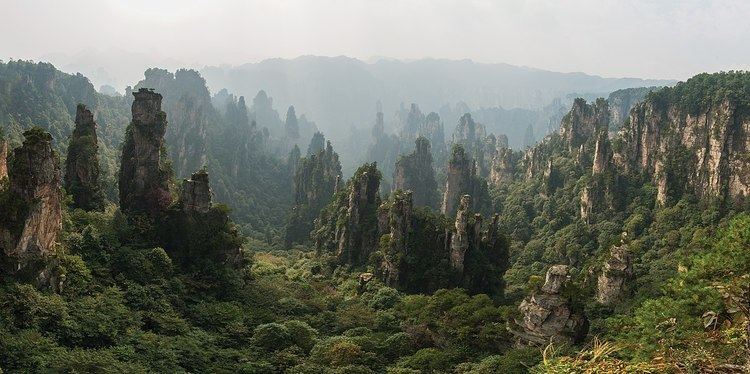Area 4,810 ha (18.6 sq mi) Phone +86 744 571 8833 | Established 1982 | |
 | ||
Hours Open today · 9AM–4PMMonday9AM–4PMTuesday9AM–4PMWednesday(Qingming Festival)9AM–4PMHours might differThursday9AM–4PMFriday9AM–4PMSaturday9AM–4PMSunday9AM–4PMSuggest an edit Similar Tianzi Mountain, Tianmen Mountain, Wulingyuan, Yuanjiajie, Huangshizhai | ||
The Zhangjiajie National Forest Park (Chinese: 湖南张家界国家森林公园; pinyin: Húnán Zhāngjiājiè Guójiā Sēnlín Gōngyuán; literally: "Hunan Zhangjiajie National Forest Park") is a unique national forest park located in Zhangjiajie City in northern Hunan Province in the People's Republic of China. It is one of several national parks within the Wulingyuan Scenic Area.
Contents
A foreigner s guide to zhangjiajie national forest park
History
In 1982 it was recognized as China's first national forest park with an area of 4,810 ha (11,900 acres). Zhangjiajie National Forest Park is part of a much larger 397.5 km2 (153.5 sq mi) Wulingyuan Scenic Area. In 1992, Wulingyuan was officially recognized as a UNESCO World Heritage Site. It was then approved by the Ministry of Land and Resources as Zhangjiajie sandstone Peak Forest National Geopark (3,600 square kilometres (1,400 sq mi)) in 2001. In 2004, Zhangjiajie Geopark was listed as a UNESCO Global Geopark.
The most notable geographic features of the park are the pillar-like formations that are seen throughout the park. Although resembling karst terrain, this area is not underlain by limestones and is not the product of chemical dissolution, which is characteristic of limestone karst. They are the result of many years of physical, rather than chemical, erosion. Much of the weathering which forms these pillars are the result of expanding ice in the winter and the plants which grow on them. The weather is moist year round, and as a result, the foliage is very dense. The weathered material is carried away primarily by streams. These formations are a distinct hallmark of Chinese landscape, and can be found in many ancient Chinese paintings.
One of the park's quartz-sandstone pillars, the 1,080-metre (3,540 ft) Southern Sky Column, had been officially renamed "Avatar Hallelujah Mountain" (阿凡达-哈利路亚山, pinyin: Āfándá hālìlùyà shān) in honor of the eponymous film in January 2010. According to park officials, photographs from Zhangjiajie inspired the floating Hallelujah Mountains seen in the film. The film's director and production designers said that they drew inspiration for the floating rocks from mountains from around the world, including those in Hunan province.
Modern Structures
The towering Bailong Elevator, literally 'hundred dragons sky lift', was opened to the public in 2002. At 326 m (1,070 ft), it is the world's tallest lift. It can transport visitors to the top from its foot in less than two minutes. The structure is composed of three separate glass elevators, each of which can carry up to 50 people at a time.
In August 2016, the Park opened the Zhangjiajie Grand Canyon Glass Bridge, the longest and highest (300 m) pedestrian glass bridge in the world. Thirteen days after opening, the bridge was closed for maintenance
